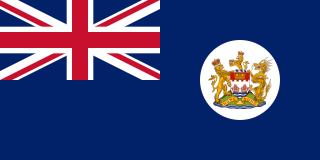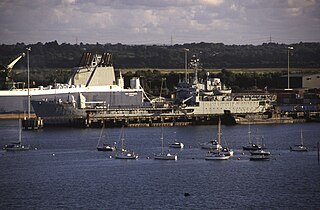
The Corps of Royal Marines (RM) is an amphibious light infantry and also one of the five fighting arms of the Royal Navy. The marines can trace their origins back to the formation of the English Army's "Duke of York and Albany's maritime regiment of Foot" at the grounds of the Honourable Artillery Company on 28 October 1664.

The units of the British Army are commanded by the Chief of the General Staff. This is broadly similar to the structures of the Royal Navy and Royal Air Force, in that the four-star (general-equivalent) commanders-in-chief have been eliminated since 2011 and service chiefs are given direct command of their respective services and are responsible as Top Level Budget (TLB) holders. Army Headquarters is located in Andover, Hampshire. There is a Commander Field Army and a personnel and UK operations command, Home Command.

The Corps of Royal Engineers, usually just called the Royal Engineers (RE), and commonly known as the Sappers, is a corps of the British Army. It provides military engineering and other technical support to the British Armed Forces and is headed by the Chief Royal Engineer. The Regimental Headquarters and the Royal School of Military Engineering are in Chatham in Kent, England. The corps is divided into several regiments, barracked at various places in the United Kingdom and around the world.

Yeomanry is a designation used by a number of units or sub-units of the British Army Reserve, descended from volunteer cavalry regiments. Today, Yeomanry units serve in a variety of different military roles.

The Royal Corps of Signals is one of the combat support arms of the British Army. Signals units are among the first into action, providing the battlefield communications and information systems essential to all operations. Royal Signals units provide the full telecommunications infrastructure for the Army wherever they operate in the world. The Corps has its own engineers, logistics experts and systems operators to run radio and area networks in the field. It is responsible for installing, maintaining and operating all types of telecommunications equipment and information systems, providing command support to commanders and their headquarters, and conducting electronic warfare against enemy communications.

The Netherlands Marine Corps is the elite naval infantry corps of the Royal Netherlands Navy. The marines trace their origins back to the establishment of the Regiment de Marine on 10 December 1665, by the then grand pensionary of the Dutch Republic, Johan de Witt and famous Admiral Michiel de Ruyter.

The Royal Yeomanry (RY) is the senior reserve light cavalry regiment of the British Army. Equipped with Supacat Jackal variants, their role is to conduct mounted and dismounted formation reconnaissance. The Regimental Headquarters is located in Leicester, with squadrons in Fulham, Nottingham, Dudley, Croydon, Telford, and Leicester.

The Royal Corps of Transport (RCT) was a British Army Corps established to manage all matters in relation to the transport of men and material for the Army and the wider Defence community. It was formed in 1965 and disbanded in 1993; its units and trades were amalgamated into the Royal Logistic Corps. The Depot and Training Regiment RCT was at the former Buller Barracks in Aldershot garrison.

British Forces Overseas Hong Kong comprised the elements of the British Army, Royal Navy and Royal Air Force stationed in British Hong Kong. The Governor of Hong Kong also assumed the position of the Commander-in-chief of the forces and the Commander British Forces in Hong Kong took charge of the daily deployment of the troops. Much of the British military left prior to the handover of Hong Kong to China in 1997. The present article focuses mainly on the British garrison in Hong Kong in the post Second World War era. For more information concerning the British garrison during the Second World War see the Battle of Hong Kong.

The ramped craft logistic (RCL) is a type of landing craft operated by 17 Port and Maritime Regiment RLC of the Royal Logistic Corps of the British Army. From the early 1980s onwards it was deployed to replace the RPL. One of their first roles was to provide logistical support during the setting up of the garrison in the Falkland Islands immediately after the Falklands War - this role was conducted by the two first of class, Arromanches and Antwerp. RCLs were originally procured for UK, Cyprus and Hong Kong, and are now only stationed at the military port at Marchwood, near Southampton, after the two based at the British base at Akrotiri, Cyprus were sold in 2014. They are slowly being withdrawn from service, as of 2015.
11 Explosive Ordnance Disposal and Search Regiment RLC is a specialist regiment of the British Army's Royal Logistic Corps (RLC) responsible for counter terrorist Explosive Ordnance Disposal (EOD), the safe recovery or disposal of conventional munitions. The regiment also has an ammunition inspectorate role supporting the Inspector Explosives (Army). With headquarters in Didcot, the regiment has sub units geographically based throughout the UK to provide a nationwide high readiness response capability in support of the police.

36th (Eastern) Signal Regiment was a Territorial Army (TA) signal unit of the British Army's Royal Corps of Signals (RCS). The regiment was formed following the formation of the TAVR in 1967, and was disbanded in 2009 following a reorganisation in the RCS. Though not disbanded, the regiment continues its lineage as a squadron, with its own former squadrons forming troops within said squadron.

37th Signal Regiment is an Army Reserve regiment in the Royal Corps of Signals in the British Army. The regiment forms part of 11th Signal Brigade, providing military communications for national operations.

Armoured reconnaissance is the combination of terrestrial reconnaissance with armoured warfare by soldiers using tanks and wheeled or tracked armoured reconnaissance vehicles. While the mission of reconnaissance is to gather intelligence about the enemy with the use of reconnaissance vehicles, armoured reconnaissance adds the ability to fight for information, and to have an effect on and to shape the enemy through the performance of traditional armoured tasks.

Marchwood Military Port (MMP) or Marchwood Sea Mounting Centre (SMC) is a military port located in Marchwood, Southampton on the south coast of the UK, and the base of 17 Port & Maritime Regiment Royal Logistic Corps. The port was built in 1943 to aid in the D-Day assault on Normandy in 1944 and has since been used to support the Falklands War.

104th Logistic Support Brigade is a specialist military logistic support formation of the British Army. The brigade is the only type of its kind, and as such contains many of the special units of the Royal Logistic Corps and Royal Electrical and Mechanical Engineers.

17 Port and Maritime Regiment is a regiment of the British Army's Royal Logistic Corps. The unit is the Army's only regular Port & Maritime capability, though it is twinned with 165 Port and Maritime Regiment RLC, of the Army Reserve.
The British Army as a result of the Army 2020 and Army 2020 Refine reforms has been organised into two main commands, Field Army and Home Command, each commanded by a lieutenant general.
This is the structure of the British Army in 1989. Units shown for their responsibilities at the end of the year. Some units will be listed with their intended 1990 changes/roles/new units, etc. The end of the Cold War was a shock, and not expected.

The 10th Railway Engineer Squadron, known operationally as 10 RW Squadron. The squadron was first formed during the pre-war expansion of the army in 1939 just before Second World War. The squadron was finally disbanded in 2013 following the initial Army 2020 reforms.













